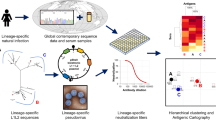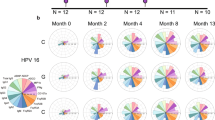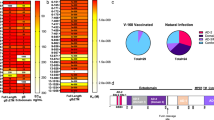Abstract
There is evidence that carcinoma of the cervix uteri is associated with infection with herpes simplex virus type 2 (HSV-2), and although indirect evidence suggests an aetiological relationship1–6, this remains controversial7–9. One facet of the problem is that complement-dependent cytotoxic antibodies to HSV-2-infected cells have been undetectable or found only in low titre in sera from patients with progressive cervical cancer whereas higher titres have been found where cervical lesions are less advanced10,11. Indeed, cytotoxic antibody titres have been found to rise during the follow-up period after successful treatment11. Absorption of these antibodies by the tumour cells has been proposed as a possible reason for low HSV-2 cytolytic reactivity in patients with progressing cervical cancer10. This explanation assumes the presence of HSV-2-specific antigen(s) on the tumour cells. We now provide support for this assumption with evidence that absorbed HSV-2-specific antibodies can be eluted from cervical cancer tissue.
This is a preview of subscription content, access via your institution
Access options
Subscribe to this journal
Receive 51 print issues and online access
$199.00 per year
only $3.90 per issue
Buy this article
- Purchase on Springer Link
- Instant access to full article PDF
Prices may be subject to local taxes which are calculated during checkout
Similar content being viewed by others
References
Nahmias, A. J. et al. Am. J. Epidemiol. 91, 547–552 (1970).
Rawls, W. E. et al. Cancer Res. 33, 1477–1482 (1973).
Seth, P. et al. Int. J. Cancer 33, 708–714 (1978).
Frenkel, N. et al. Proc. natn. Acad. Sci. U.S.A. 69, 3784–3789 (1972).
Aurelian, L. et al. Science 174, 704–707 (1971).
Abrahim, A. N. et al. Proc. Soc. exp. Biol. Med. 152, 343–347 (1976).
Zur Hausen, H. Biochim. biophys. Acta 417, 25–53 (1975).
Melnick, J. L. & Adam, E. Prog. exp. Tumour Res. 21, 49–69 (1978).
Nahmias, A. J. & Sawanabori, S. Prog. exp. Tumour Res. 21, 117–139 (1978).
Christenson, B. Int. J. Cancer 20, 694–701 (1977).
Thiry, L. et al. Am. J. Epidemiol. 100, 251–261 (1974).
Gupta, R. K. & Morton, D. L. Cancer Res. 35, 58–62 (1975).
Lowry, O. H. et al. J. biol Chem. 193, 265–275 (1951).
McClung, H. et al. Am. J. Epidemiol. 104, 181–191 (1976).
Brunner, K. T. et al. Immunology 14, 181–196 (1968).
Balachandran, N. et al. J. gen. Virol. 45, 65–72 (1979).
Bastian, F. O. et al. Science 178, 306–307 (1972).
Moller, G. Nature 204, 846–847 (1964).
Witz, I. P. Adv. Cancer Res. 25, 95–148 (1978).
Seth, P. et al. Clin. exp. Immun. 38, 77–82 (1979).
Author information
Authors and Affiliations
Rights and permissions
About this article
Cite this article
Seth, P., Balachandran, N. Elution of herpes simplex virus-specific cytotoxic antibodies from squamous cell carcinoma of uterine cervix. Nature 286, 613–615 (1980). https://doi.org/10.1038/286613a0
Received:
Accepted:
Issue Date:
DOI: https://doi.org/10.1038/286613a0
This article is cited by
Comments
By submitting a comment you agree to abide by our Terms and Community Guidelines. If you find something abusive or that does not comply with our terms or guidelines please flag it as inappropriate.



